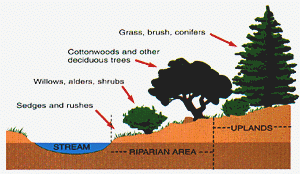| Français | Contact Us | Help | Search | Canada Site | |||||
| AAFC Online | Links | Newsroom | What's New | Site Index |
| PFRA Online | Staff | Programs & Services | Offices | ||||
Prairie Farm Rehabilitation Administration |
||||||||
|
|
||||||||
| |
Managing Livestock in the Riparian ZoneA riparian zone is the strip of land bordering a creek, river, lake, slough or any other body of water. Even a manmade dugout has a riparian zone. Riparian zones are usually densely covered with a variety of trees, shrubs, grasses and other vegetation. Riparian zones are fragile areas and must be carefully managed. A key feature is that the zone's underlying saturated soil supports a variety of plants and trees. Without vegetation the area can become eroded to the point where it provides no benefit to the land, water or livestock.  Benefits of a Healthy Riparian ZoneAlthough the riparian zone occupies a relatively small percentage of the watershed, it represents an extremely important component of the overall landscape. Water Quality: The riparian zone acts as a buffer strip between the water and the surrounding landscape, trapping sediments, nutrients, chemicals and animal wastes from neighboring fields. This helps to reduce algae blooms that lower water quality, suffocate fish and create problems along recreational beach areas. Wildlife :In many parts of the Prairies, riparian zones provide habitat for most wildlife species in the region. Fish: Along stream banks and lakeshores, trees and other vegetation near the water's edge provide shade for fish and other aquatic life and help keep the water cool in summer. These plants also support many insects that provide food for fish. Branches and trees that fall into the water become hiding and feeding places for fish. Water Management: A well-vegetated riparian zone can slow flood waters, decreasing erosion and reducing flash flooding downstream. It also provides an area of groundwater recharge and helps maintain reliable stream flows year-round. Woodlot Potential: In some cases, trees in the riparian area are large enough to support a small commercial lumbering venture, usually in hardwoods, if properly managed as a woodlot over the long term. Sediment Reduction: Proper management of the riparian zone minimizes streambank and shoreline erosion and reduces sedimentation downstream, which in turn lowers waterway maintenance and water treatment costs. Excess sediment can also destroy fish spawning habitat and turn beaches into quagmires. Management ApproachRiparian areas can be managed to allow livestock use while maintaining the integrity of water, soils and vegetation in the zone. Access to the WaterTraditionally, livestock have had unrestricted access to the water. This can result in many problems. Cattle that spend time in the water and mud are susceptible to diseases such as foot rot and mastitis. The water becomes contaminated with livestock waste, providing a medium for the transfer of many other livestock diseases. Calves may have difficulty nursing from mud-caked udders. Animals can become bogged down in the mud. Livestock, especially calves, may fall through thin ice or be swept away by high water. Livestock trample the shoreline, increasing erosion and sedimentation. In the water, they destroy aquatic vegetation and stir up mud and sediments. Cattle will drink less water when it is dirty, resulting in lower beef and milk production. Preferred method: no direct access to the water
Alternative method: restricted access to the water
Managing the ShoreLandManage livestock use of the riparian zone to protect the vegetation that holds the soil in place and provides food and shelter for the animals. Ideally, a 30 foot wide buffer strip along the water's edge should be fenced to completely exclude livestock. This area is most critical for protecting the water and associated shoreland. The carrying capacity of the riparian zone must be carefully calculated and heeded. A system of rotational grazing can be very useful in managing riparian areas. Divide the area into paddocks and move the herd from one paddock to another to avoid over-grazing. Better grasslands mean better livestock weight gain. Detailed information about watering systems is available from suppliers or from Manitoba Agriculture and PFRA offices. Keeping cattle out of the water has many benefits
|
|||||||
|
||||||||